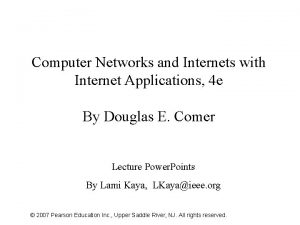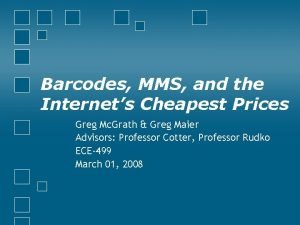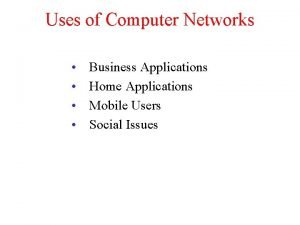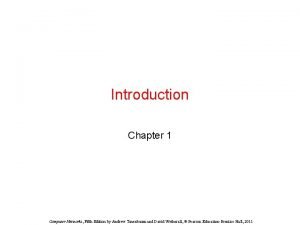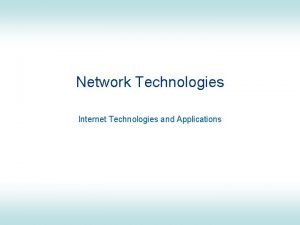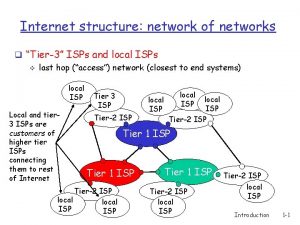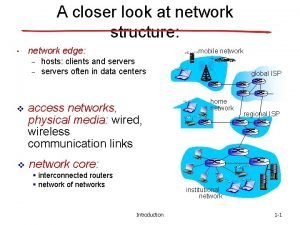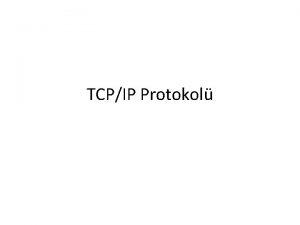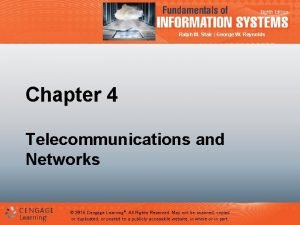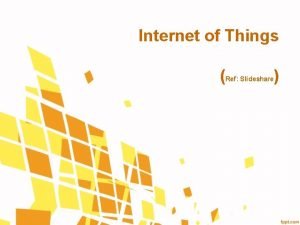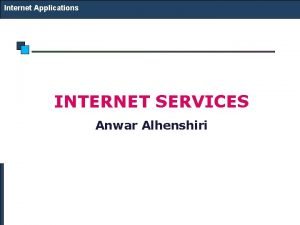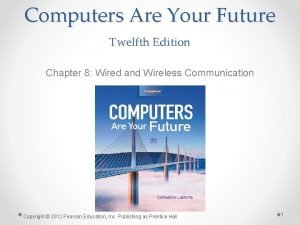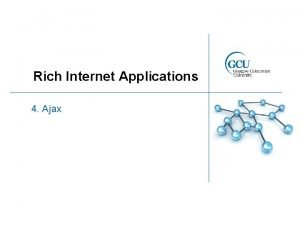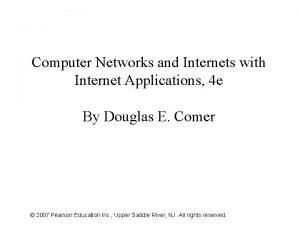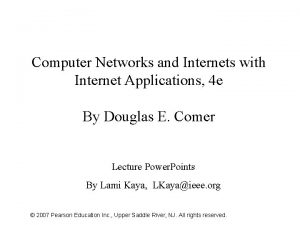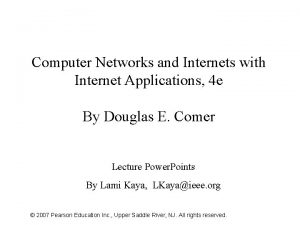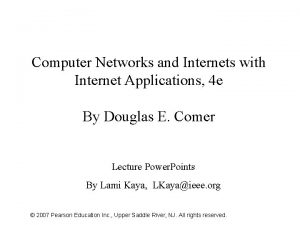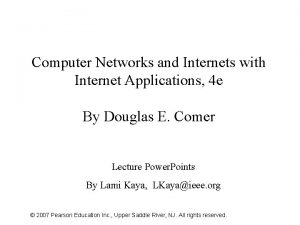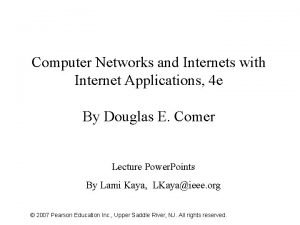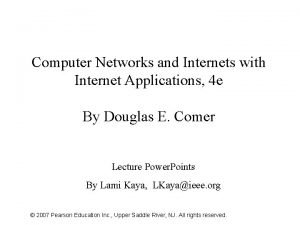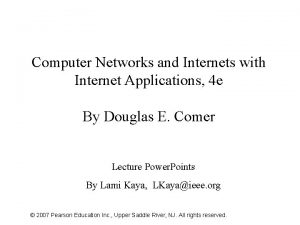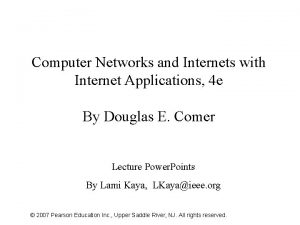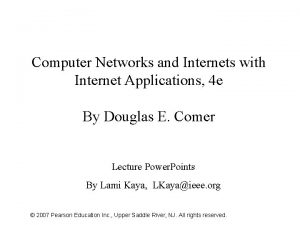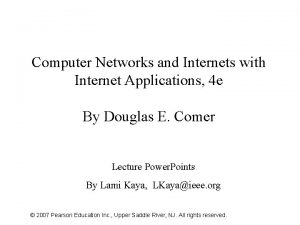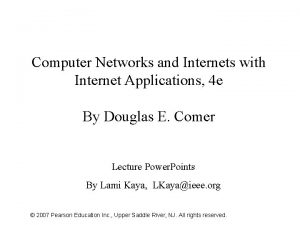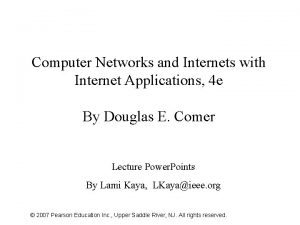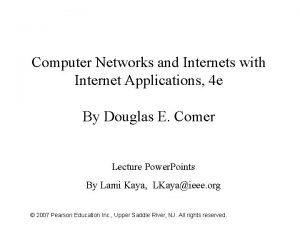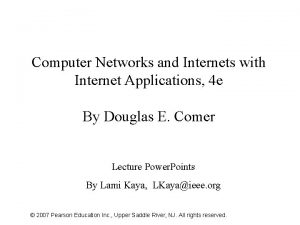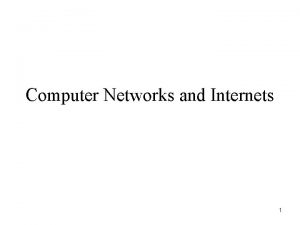Computer Networks and Internets with Internet Applications 4





























- Slides: 29

Computer Networks and Internets with Internet Applications, 4 e By Douglas E. Comer Lecture Power. Points By Lami Kaya, LKaya@ieee. org © 2007 Pearson Education Inc. , Upper Saddle River, NJ. All rights reserved.

Chapter 14 Connection-Oriented Networking And Asynchronous Transfer Mode (ATM) © 2007 Pearson Education Inc. , Upper Saddle River, NJ. All rights reserved.

Topics Covered • • • 14. 1 Introduction 14. 2 A Single, Global Network 14. 3 ISDN And ATM 14. 4 ATM Design And Cells 14. 5 Connection-Oriented Service 14. 6 VPI / VCI 14. 7 Labels And Label Switching 14. 8 An Example Trip Through An ATM Network 14. 9 Permanent Virtual Circuits 14. 10 Switched Virtual Circuits © 2007 Pearson Education Inc. , Upper Saddle River, NJ. All rights reserved.

Topics Covered (cont) • 14. 11 Quality Of Service • 14. 12 The Motivation For Cells And Label Switching – 14. 12. 1 Cells vs. Packets. – 14. 12. 2 Label Switching Vs. Routing • 14. 13 ATM Data Transmission And AAL 5 • 14. 14 Critique Of ATM • 14. 15 Multi Protocol Label Switching (MPLS) © 2007 Pearson Education Inc. , Upper Saddle River, NJ. All rights reserved.

14. 1 Introduction This chapter • explores a single technology that was designed to fill both roles • presents a technical overview • explains the underlying motivation • introduces the connection-oriented PS paradigm © 2007 Pearson Education Inc. , Upper Saddle River, NJ. All rights reserved.

14. 2 A Single, Global Network A new NW infrastructure with extremely ambitious goals: • Universal Service • Support For All Uses • Single, Unified Infrastructure – The new NW should not be formed from multiple technologies – NW should be capable of serving as a LAN or as a WAN • Service Guarantees – perform with the same reliability and efficiency as existing NWs – offer the same delivery guarantees that voice and video NWs • Support For Low-Cost Devices – allow users to connect small, low cost devices such as ATM telephones © 2007 Pearson Education Inc. , Upper Saddle River, NJ. All rights reserved.

14. 3 ISDN And ATM • One of the attemp to satisfy the NW goals was – Integrated Services Digital NW (ISDN) • As the planning, standardization, development, and deployment of ISDN proceeded – NW changed rapidly and dialup modem technology advanced • When ISDN finally emerged – it was expensive for the moderate data speeds it offered – ISDN has not gained universal acceptance • After ISDN, the telecom industry developed a more comprehensive technology to satisfy its goals – Asynchronous Transfer Mode (ATM) © 2007 Pearson Education Inc. , Upper Saddle River, NJ. All rights reserved.

14. 4 ATM Design And Cells (1) • ATM designers faced a difficult challenge – because three intended uses (voice, video, and data) have different sets of requirements • For example – both voice/video require low delay/ jitter (ie, low variance in delay) • make it possible to deliver smoothly without gaps or delays – video requires a substantially higher data rate than audio – most data NWs introduce jitter as they handle packets • Packet size is a key issue in designing a NW technology – Data achieves maximal throughput when packet sizes are large • Because the overhead from headers is minimized by carrying a maximum payload with each header © 2007 Pearson Education Inc. , Upper Saddle River, NJ. All rights reserved.

14. 4 ATM Design And Cells (2) • Voice transmission cannot use such large packets for two reasons • First, PCM, produces an 8 -bit audio sample every 125 seconds – If packet size greater than 4000 octets, a sender must delay for more than half a second while accumulating enough samples to fill the packet • Second, users are also intolerant of echo – a problem that occurs when signals traveling in one direction are inadvertently amplified and transmitted back to the sender – telephone systems employ echo cancellation – Unfortunately, echo cancellation only works when delays are low • If large packets used, the delay introduced by waiting to fill a packet makes echo cancellation difficult • ATM technology divides data into small, fixed-size “cells” • Each ATM cell contains exactly 53 -octets – 5 octets of header information and 48 octets of data • Figure 141 illustrates the format of an ATM cell © 2007 Pearson Education Inc. , Upper Saddle River, NJ. All rights reserved.

© 2007 Pearson Education Inc. , Upper Saddle River, NJ. All rights reserved. 10

14. 4 ATM Design And Cells (3) As the figure shows, • Most header bits are devoted to two VPI and VCI – These fields together identify the cell's destination • Other fields specify a payload type and give an 8 -bit CRC • PRIO is a Cell Loss Priority bit that identifies – if a packet can be discarded when the NW becomes congested © 2007 Pearson Education Inc. , Upper Saddle River, NJ. All rights reserved.

14. 4 ATM Design And Cells (4) • Proponents of ATM argue that – A single technology must handle all possible communication • Critics suggest that – ATM is neither optimal for voice nor for data – the relative size of the header, is not suitable for data transmission • When ATM was designed, the designers decided – to limit the header to ten percent of the payload area – payload 48 bytes was chosen, the header was fixed at 5 bytes • For data NW 10% percent header overhead is high © 2007 Pearson Education Inc. , Upper Saddle River, NJ. All rights reserved.

14. 5 Connection-Oriented Service • ATM uses a connection-oriented service paradigm – Before two computers can communicate, they must establish a ``connection'‘ – HW establishes a data path called a connection and returns a “connection identifier” to each of the two computers – An ATM switch extracts the connection identifier and consults a table to determine how to forward the cell © 2007 Pearson Education Inc. , Upper Saddle River, NJ. All rights reserved.

14. 6 VPI / VCI (1) • Formally, an ATM connection is known as a – Virtual Channel (VC) • Term “virtual” is appropriate because – ATM connections are formed by storing values in memory rather than by attaching physical wires • The term “channel” is less descriptive • Many professionals expand the acronym VC to the more descriptive term – Virtual Circuit © 2007 Pearson Education Inc. , Upper Saddle River, NJ. All rights reserved.

14. 6 VPI / VCI (2) • ATM assigns each VC a 24 -bit identifier that is divided into two parts • First part, a Virtual Path Identifier (VPI) – specifies the path the VC follows through the NW – As Figure 14. 1 shows, a VPI is 8 bits long • The second part, a Virtual Channel Identifier (VCI) – specifies a single VC within the path – A VCI is 16 bits long • The computer views the two parts as a single – 24 -bit binary value that gives the connection identifier • Because a computer refers to both parts together – the identifier is known as a VPI / VCI © 2007 Pearson Education Inc. , Upper Saddle River, NJ. All rights reserved.

14. 7 Labels And Label Switching • Each ATM switch has multiple physical attachment points – connect to a user's computer or to another switch – the attachment points are known as “ports” • An ATM switch changes the VPI / VCI in each cell • Inside each switch is a “forwarding table” – Each entry in the table corresponds to a possible VPI / VCI • The table entry contains a replacement VPI / VCI • Switch rewrites the VPI / VCI in the cell header with the replacement, and forwards the cell – Known as “label rewriting” or “label switching” • A VPI / VCI in a cell does not remain the same as the cell traverses the NW, see Figure 14. 2 © 2007 Pearson Education Inc. , Upper Saddle River, NJ. All rights reserved.

© 2007 Pearson Education Inc. , Upper Saddle River, NJ. All rights reserved. 17

14. 8 An Example Trip Through An ATM Network • How label switching extends to a large ATM NW? • The forwarding tables in a series of switches must be coordinated to create a ``path'' through the NW • Figure 143 illustrates a set of three ATM switches – shows the values in the forwarding tables that correspond to a single VC between two computers © 2007 Pearson Education Inc. , Upper Saddle River, NJ. All rights reserved.

© 2007 Pearson Education Inc. , Upper Saddle River, NJ. All rights reserved. 19

14. 9 Permanent Virtual Circuits • How and when are entries in an ATM forwarding table filled in? • How are entries coordinated across a large number of switches to ensure that they are correct? • This section answers each of these questions • ATM offers a facility that is analogous to a leased digital circuit – called permanent virtual channel (PVC) • To establish a PVC, the NW manager configures entries in the • forwarding tables manually • The technical term used by telephone companies (and ATM) for such configuration is “provisioning” © 2007 Pearson Education Inc. , Upper Saddle River, NJ. All rights reserved.

14. 10 Switched Virtual Circuits • To handle dynamic interaction, ATM includes a facility that allows VCs to be established and terminated as needed • A VC can be created dynamically – called Switched Virtual Channel (SVC) • Each pair of ATM switches along the path communicate to choose a VPI / VCI to use for the VC and initialize their tables – If any switch along the path does not agree to provide the VC, an error message is sent back and the request is denied • How does a computer interact with an ATM to request an SVC? – The process, which is known as “signaling” requires control messages – ATM reserves a small set of VPI / VCI values for connection requests and NW control traffic – The reserved values can only be used across one connection © 2007 Pearson Education Inc. , Upper Saddle River, NJ. All rights reserved.

14. 11 Quality Of Service (1) • To satisfy the needs of audio and video users, ATM has facilities that allow a subscriber to specify – quality of service (Qo. S) • ATM uses fine-grain quality of service because it allows a subscriber to specify quantitative values • Qo. S specifications are given when the connection is established, – and stay in effect until the connection is terminated – once a request has been approved • the switches must reserve capacity as promised – an ATM NW cannot behave like a shared channel © 2007 Pearson Education Inc. , Upper Saddle River, NJ. All rights reserved.

14. 11 Quality Of Service (2) • ATM has several basic ways to specify Qo. S requirements • Constant Bit Rate (CBR) – For applications like compressed audio or video • the transmission rate depends on the amount of change in the input during each sample • Variable Bit Rate (VBR) – For applications that know in advance they will vary the rate of traffic • Available Bit Rate (ABR) – The transmission may be bursty, with short periods of intense communication, separated by long periods of silence – use whatever BW is available at a given time © 2007 Pearson Education Inc. , Upper Saddle River, NJ. All rights reserved.

14. 12 The Motivation For Cells And Label Switching Several questions arise • Why did ATM designers choose fixed-size cells instead of variable-size packets? • What is the chief advantage of label switching, and why did ATM adopt it? • The answers are the same – to achieve maximum data rates and satisfy Qo. S requirements © 2007 Pearson Education Inc. , Upper Saddle River, NJ. All rights reserved.

14. 12. 1 Cells vs. Packets NW HW could be optimized if all packets were exactly the same size and had exactly the same header format: • 1 st, variable-size packets can cause memory fragmentation; fixedsize cells do not • 2 nd, variable-size packets require the HW to accommodate the largest possible incoming packet and to detect the end of the packet • 3 rd, interface HW that transmits variable-size packets must interact with the switch • 4 th, variable-size packets make it difficult to guarantee Qo. S, especially low jitter • Thus, the ATM designers chose fixed-size cells rather than variablesize packets for efficiency © 2007 Pearson Education Inc. , Upper Saddle River, NJ. All rights reserved.

14. 12. 2 Label Switching Vs. Routing • Label switching is another technology that increases HW speed and capacity • The HW has little to do when a cell arrives – extraction of the VPI / VCI and table lookup can both be implemented directly in HW; no CPU is required • As a result, the raw capacity of an ATM switch is usually quite high – For example, a typical ATM switch, designed as a LAN replacement, has an aggregate throughput capacity of 24 Gbps © 2007 Pearson Education Inc. , Upper Saddle River, NJ. All rights reserved.

14. 13 ATM Data Transmission And AAL 5 • ATM defines a set of adaptation protocols – which can be thought of as a set of API • Although five adaptation protocols have been defined – Only ATM Adaptation Layer 5 (AAL 5) is used to send data – On the sending side, • AAL 5 accepts a block of data (up to 64 K octets), • divides the block into cells • and transfers the cells across the ATM NW as usual – On the receiving side, • AAL 5 accepts incoming cells • extracts the data • and delivers the original block – The process is known as “segmentation” and “reassembly” © 2007 Pearson Education Inc. , Upper Saddle River, NJ. All rights reserved.

14. 14 Critique Of ATM The ATM technology has several drawbacks: • Expense • Connection Setup Latency • Cell Tax • Specification of Service Requirements • Lack Of Efficient Broadcast • Complexity of Qo. S • Assumption Of Homogeneity © 2007 Pearson Education Inc. , Upper Saddle River, NJ. All rights reserved.

14. 15 Multi Protocol Label Switching (MPLS) • Although ATM did not become popular – proponents continue to devise and promote variations of connection-oriented NW • One version of connection-oriented NW goes by the name Multi Protocol Label Switching (MPLS) • Instead of attempting to completely replace the Internet – MPLS is designed to serve in the Internet core • The basic idea is to use ATM-like label switches to provide virtual circuits among IP routers – Chapter 17 describes IP routers © 2007 Pearson Education Inc. , Upper Saddle River, NJ. All rights reserved.
 Computer networks and internets with internet applications
Computer networks and internets with internet applications Computer networks and internets
Computer networks and internets Virtual circuits and datagram networks
Virtual circuits and datagram networks Compare internets
Compare internets Backbone networks in computer networks
Backbone networks in computer networks Applications of computer networks
Applications of computer networks Principles of network applications in computer networks
Principles of network applications in computer networks Business application in computer network
Business application in computer network Business application in computer network
Business application in computer network Internet transport protocol in computer networks
Internet transport protocol in computer networks Aim lans
Aim lans Tier 3 isps
Tier 3 isps Internet structure network of networks
Internet structure network of networks Which type of address is this: a3:34:45:11:92:f1
Which type of address is this: a3:34:45:11:92:f1 Osi vs tcp/ip
Osi vs tcp/ip Integrated services vs differentiated services
Integrated services vs differentiated services Error detection in computer networks
Error detection in computer networks Bit and byte stuffing
Bit and byte stuffing Bit stuffing and character stuffing
Bit stuffing and character stuffing Arp rarp protocol
Arp rarp protocol Analogue and digital transmission in computer networks
Analogue and digital transmission in computer networks Http computer networks
Http computer networks Hamming distance in computer network
Hamming distance in computer network Protocols and standards in computer networks
Protocols and standards in computer networks Error correction in computer networks
Error correction in computer networks Applications of internet
Applications of internet Internet of things ppt slideshare
Internet of things ppt slideshare Applications of internet
Applications of internet Applications of internet
Applications of internet Rich internet applications with ajax
Rich internet applications with ajax

